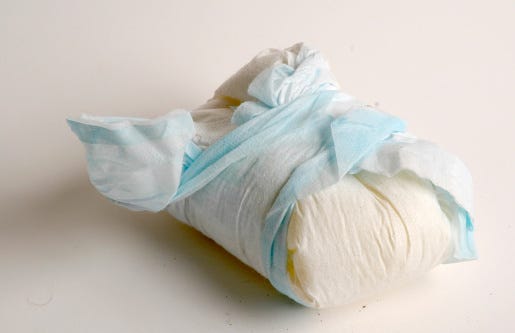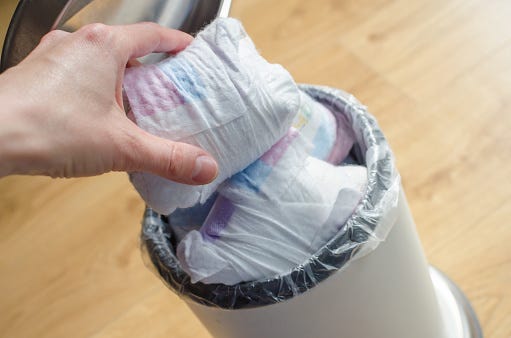
How many disposable nappies would a baby wear during the first few years before being toilet trained? It is an alarming amount close to 4000–6000.
To make matters worse, used nappies are mixed waste. When mixed with human excreta used nappies cannot be directly recycled as plastic waste. As with many other absorbent hygiene products (AHP), such as menstrual absorbents and adult continence products bearing both biological and plastic waste, there exists a challenge when recycling or managing end of life stage of disposable baby nappies.

Environmental footprint
The environmental footprint of disposable baby nappies become evident in the alarming facts that;
· (AHP) industries estimate that annually, 30 million tonnes of their products end up in the world’s landfills.
· Around 800 million disposable nappies in Australia end up in landfills every year.
· The plastics in disposable nappies reportedly take roughly 200 to 500 years to break down and the methane released from the soiled nappies is 21 times more greenhouse gas potential than carbon dioxide.
Seeing these facts would compel some individuals to ditch the use of nappies and integrate other alternatives such as reusable liners or cloth nappies into their routine. However, there are those who are unable to make that switch due to various constraints, primarily those to do with time.
So how do we overcome those challenges in designing things in a new way; in line with the principles of a circular economy and how do those new options fare if we compare them?

Evaluating alternatives
Let’s look at the alternatives that could solve the problem and identify which of these solutions most effectively accomplish this.
- Using cloth nappies or reusable products
When it comes to alternatives, the use of cloth nappies designed for reuse is a viable and environmentally sound option. Cloth nappies are reusable and regenerative. With human excreta easily following the conventional path of heading down the toilet, there will be no biological waste to manage. There are also social benefits to this option as this could enable children to toilet train at an early age.

Nevertheless, this option is not without its drawbacks. Firstly, the nutrients within excrement are not recovered to benefit the cycle of nature as they are entirely disposed of as waste (as we do usually). Also, it is found that the carbon footprint of cloth nappies are slightly worse compared to that of disposable nappies (550kg to 580 kg for nappy use over 2.5 years).
2. Recycling disposable nappies
Developed conventionally using synthetic material, disposable nappies can be recycled to recover biological waste through the use of chemicals and energy. Countries across the world today have taken up the challenge of recycling AHP products by exploring various technological and creative innovations.
These nappy recycling plants focuses on reclaiming material such as paper fibre, plastic and super absorbent polymer from the AHPs. The technology used in this type of processes lets the nappies to remove pathogens through sanitisation followed by the efficient segregation of the material to be directed to the central recycling centre which will then convert those into various other items such as paper products, trash cans etc.
Recycling disposable nappies (and other AHP products) have inherent constraints.
It is a complex process, which involves washing, screening to segregate plastic and organic waste, treatment, etc which is generally energy and resource intensive. For example, it requires a considerable amount of hot water to break down the adhesives found in the product and hence consumes energy.
Further, the recycling process results in material recovery from plastic and organic waste, waste water requiring treatment and a quantity of solid waste that needs to be managed. Considering all these, recycling nappies is nothing other than a sub-optimal process.
Not all recycling facilities are able to sustain themselves as someone needs to pay the cost of a series of chemical and physical treatment. If the tax payer is not willing to pay for it, either collectively or individually based on use, the recycling operation does not become viable, leaving no other option than to send it to landfills, as happened before.
3. Nappies made to be biodegradable
There are other alternatives that overcome those inherent constraints, if we think of the fundamental need fulfilled with the product and consider redesign.
An example of a best practice comes from the community start-up DYCLE (denoting The Diaper Cycle) which was co-founded in Berlin by Ayumi Matsuzaka and Christian Schloh.
DYCLE has developed an entirely plastic-free and biodegradable diaper or nappy product. The business model also focuses on adding nutrient-rich human excrement collected from the nappies back into the cycle by generating soil fertiliser for growing trees. The project empowers a community of mothers who engage in the collection of nappies. The thinking that is challenged through this approach is to consider human excreta as a nutrient, rather than a waste and to consciously design the value chain to divert it to the right place.
While bio-degradable nappies offer the same user experience, it involves a simpler treatment pathway that simultaneously handles the nappy and excreta. Also, this concept complements with the placenta burial ritual of some countries around the world which nourishes the soil following the birth of a child. It provides a solution that can add the content of products as nutrients, sustainably and reliably back to nature. This also shows strong alignment with cultural practices and societal/community harmony.
We need to know more about the environmental footprint and cost to have better insights on what out of the alternatives perform better in those criteria.
When the current solutions offer so many constraints, we need to open up ourselves to think of alternatives concerning a bigger system boundary, encompassing upstream activities of design and production. We may see other possibilities that bring better outcomes– socially, environmentally and economically, and offer the advantage of effective regeneration as a true circular economy entails.
- The word “diaper” is often used in North America, to what we call “nappy” in Commonwealth countries.